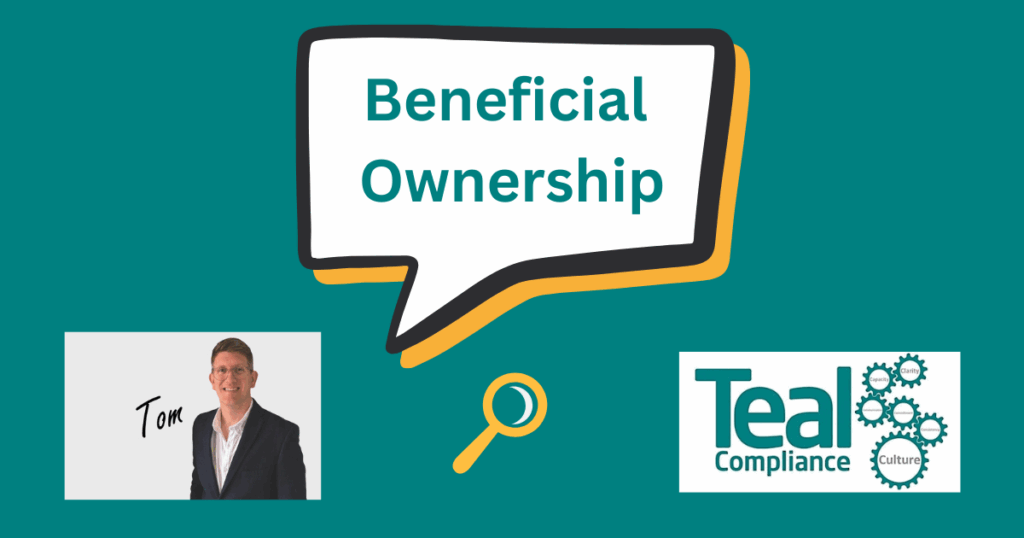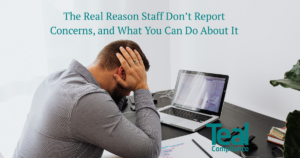Whether you’re based in the UK or Australia (where our sister firm AML Sorted is based), are a law firm whose areas of law offer corporate and commercial law, you’re going to need to know what Beneficial Ownership means.
The UK and Australian governments and regulatory bodies are pretty clued up on these risks, which is why they’ve brought in some stringent anti-money laundering (AML) regulations. Understanding beneficial ownership information is a central requirement of those regulations, and it’s critical to your firm’s AML compliance and control structures.
Contents
- Understanding beneficial ownership
- Definition of an individual PSC of a UK company
- Definition of a beneficial owner of an overseas entity
- Examples of concealing beneficial ownership
- Don’t rely on the corporate veil — lift it
- Challenge vague answers
- Document the risk rationale
- Verify control, not just ownership
- Watch for layered structures
- US Legislation News
Understanding beneficial ownership
When we talk about ‘beneficial ownership,’ it’s all about figuring out who really owns or controls something, whether it’s a property or a company. It’s not just about the names on the official paperwork, ie…. the ‘legal owners.’ For specialists like us at Teal Compliance, and AML Sorted, we’re like detectives, digging deeper and deeper until the ownership and control is truly transparent. In another life instead of solicitors and AML compliance experts we’d be investigative journalists!
In the world of property and conveyancing, as an example, we’ve got to identify and check who’s actually pulling the strings and getting any benefit from a property deal, even if they’re not the ones listed on the deeds. Our job in AML compliance is to support you, the law firms and the MLROs, protect your bottom line and your reputation whilst ensuring financial criminals are held to account.
Identifying beneficial owners is really important when we’re trying to stop money laundering because criminals are sneaky. They often hide their dirty money by owning entities that are set up through complicated setups like shell companies and trusts. It makes it really hard for anyone to trace where the money really came from.
In this blog, when we use the acronym PSC, this means person with significant control.
Definition of an individual PSC of a UK company
In accordance with the Economic Crime and Corporate Transparency Act: beneficial ownership (last updated on 1st March 2024) the definition of an individual PSC of a UK company comes under Schedule 1A, where it states that if an individual (“X”) meets one or more of the following conditions in relation to a company (“Y”), they must be registered as a PSC in respect of Y:
- X holds, directly or indirectly, more than 25% of the shares in company Y.
- X holds, directly or indirectly, more than 25% of the voting rights in company Y.
- X holds the right, directly or indirectly, to appoint or remove a majority of the board of directors of company Y.
- X has the right to exercise, or actually exercises, significant influence or control over company Y.
- The trustees of a trust or the members of a firm that, under the law by which it is governed, is not a legal person meet any of the other specified conditions in relation to company Y, or would do so if they were individuals, and, X has the right to exercise, or actually exercises, significant influence or control over the activities of that trust or firm.
- If you want to dig deeper into LSAG’s definition of a beneficial owner when it comes to the topic of TRUSTS, law firms should verify settlors, beneficiaries, protectors, and the assets the trust holds (not just the trustee). You can read more under LSAG Section 6.14.12.2) or of course, get in touch with us or become an ASK TEAL client.
Definition of a beneficial owner of an overseas entity
Under paragraph 6 of Schedule 2 to the Economic Crime (Transparency and Enforcement) Act 2022, a person (“X”) is a beneficial owner of an overseas entity or other legal entity (“Y”) if one or more of the following conditions are met:
- X holds, directly or indirectly, more than 25% of the shares in Y.
- X holds, directly or indirectly, more than 25% of the voting rights in Y.
- X holds the right, directly or indirectly, to appoint or remove a majority of the board of directors of Y.
- X has the right to exercise, or actually exercises, significant influence or control over Y.
- The trustees of a trust, or the members of a partnership, unincorporated association or other entity, that is not a legal person under the law by which it is governed meet any of the conditions specified above in relation to Y, and, X has the right to exercise, or actually exercises, significant influence or control over the activities of that trust or entity. Note: please reference 5.a above for more information on LSAG and trusts.
Examples of concealing beneficial ownership
The National Crime Agency’s (NCA) news page is full of crimes and it’s worth having a read to keep you and your compliance officers on their toes. The agency always says to keep a look out for changes in client circumstances. Are the international sanctions’ listings checked on a daily basis? If your client is an art dealer or auction house and your diligence measures flag up questions over their source of funds on their artwork, get them to check these red flags:
- Attempts to transfer artwork or cultural property ownership to a family member, close contact, business associate or other intermediary, or
- Attempts to sell artwork or cultural property quickly, or move it to another jurisdiction.
Be especially vigilant when dealing with front or shell companies, or intricate corporate or trust structures that obscure the ultimate beneficial owner. While it’s tempting to prioritise well-paying, existing clients, the heightened focus on combating money laundering means your firm faces significant risk if you’re flagged for inadequate AML compliance by the SRA.
Definition of Beneficial Owners: those that might benefit from their ownership of an entity or asset (eg a company.) You will need to identify and undertake reasonable measures to verify the identity of your clients, especially when dealing with high-risk clients or transactions.
Don’t rely on the corporate veil — lift it
Always identify the natural person(s) behind any legal entities. Shell companies and complex structures can hide risk — dig and keep digging, until you find the ultimate beneficial owner (UBO), not just the named shareholders.
If you are concerned about upsetting your client, find ways of carrying out your due diligence and be specific and clear about what you need at the outset.
Why not provide a list to your client with the information you need and if they push back have the back up to explain the purpose.
You should always ask for their details – see below (where applicable) to support and evidence your AML processes and controls. The SRA and your insurer will thank you for this….
- Shareholder registers
- Company structure charts
- Trust deeds
Challenge vague answers
Here’s an example of what your MLRO might be up against….
Client: “Oh, the company is owned by a few investors.”
Reply with… “To comply with regulations, we need to identify the individuals who ultimately own or control the company. Could you please provide a list of all shareholders with more than 25% ownership, and details about anyone who has significant control over the company’s decisions? We really want to protect your own interests and this information will support this.”
Document the risk rationale
Keep clear notes on why a client is low, medium, or high risk, especially if beneficial ownership is complex. You’ll thank yourself during audits or inspections.
Our own software, the TEAL TRACKER, supports your documentation and evidence in this regard because it includes a high-risk client register, an undertakings register, incident management tracker, file reviews and more.
Here’s the framework we are aligning ourselves to, and knowing which legislation your tracking and note taking adhere to will help you and your team.
Money Laundering Regulations 2017: These regulations are the cornerstone of AML compliance in the UK and place a legal obligation on firms to identify beneficial owners.
Economic Crime (Transparency and Enforcement) Act 2022: This Act introduced the Register of Overseas Entities, further emphasizing the importance of beneficial ownership transparency, especially in relation to UK property.
Proceeds of Crime Act 2002 (POCA): This is the legal backbone of the UK’s fight against money laundering and places stringent obligations on law firms to be vigilant, to have strong AML controls, and to report suspicious activity.
Companies Act 2006 (in particular Schedule 1A): In this act, it defines “People with Significant Control” (PSCs) for UK companies, which is closely related to the concept of beneficial ownership.
Verify control, not just ownership
Control can be exercised in various ways, and it’s important to look beyond just shared ownership.
A person can be an ultimate beneficial owner (UBO) if they exercise significant control, even if their shareholding is below 25%, for example when your client is an LLP. Check for influence via voting rights, directorships, or veto powers.
Red flags to be on high alert for include:
Nominee Directors or Shareholders: The use of nominees to hold shares or directorships.
Lack of Transparency: Reluctance to provide information or vague answers about ownership and control.
Inconsistent Information: Discrepancies between information provided by the client and information from other sources.
Why not do your research and look into their confirmation statements, do they have information on control of beneficial ownership on their websites, or are Board Minutes available to you?
Check on the Registers for Beneficial Owners website, and run a check on the background and relationships of the company’s directors and senior management.
Watch for layered structures
Multiple holding companies across jurisdictions may indicate masking of the truth! You’d want to understand the chain until you reach a human being. We appreciate that layered ownership structures can feel like untangling a particularly tricky ball of wool, but the key is to break it down step by step—each layer tells part of the story.
What would you do in the following scenarios?
- Multiple Layers of Ownership where ownership is divided across several entities, often spanning different jurisdictions (e.g. Company A owns Company B, which owns Company C, and so on).
- Use of Shell Companies, which are entities that exist only on paper, with no significant business activities, often used to add layers of ownership without transparency.
- Circular Ownership, which occurs when entities within the structure own shares in each other, creating a loop that obscures the ultimate beneficial owner (UBO).
- Offshore Jurisdictions are entities registered in jurisdictions with high levels of secrecy and minimal disclosure requirements are often included to complicate tracking.
- Nominee Directors or Shareholders (as mentioned above), can be individuals or entities who are listed as directors or shareholders but act on behalf of the true owners without having actual control or interest.
- Frequent Changes – watch out for regular changes in ownership, directors, or shareholders because these can make it harder to establish a clear picture of control.
- Trusts and Foundations are legal arrangements that can be used to conceal the identity of the true owners by placing assets under the control of trustees or foundations.
The above structures are often red flags for money laundering, tax evasion, or other illicit activities. In these circumstances, your enhanced due diligence (EDD) measures, such as verifying the identities of beneficial owners and understanding the ownership structure, are crucial to back you and your practice up.
US Legislation News For Information
It’s worth noting that the US has also stepped up its efforts in corporate transparency, introducing new provisions that came into effect on 1st January 2024. These rules now require certain corporate entities in the States to report information about their beneficial owners.
Much like the corporate transparency legislation we’ve seen introduced in other parts of the world, including our own measures here in the UK, the overarching goal is to make it tougher for those with illicit intentions to conceal their activities behind shell companies or other murky ownership structures. The hope is that this increased transparency around who really owns and controls these entities will be a significant weapon in the ongoing fight against money laundering and the financing of terrorism.
To wrap this article up, the one thing I urge you to remember, is that it’s up to you to take reasonable measures to verify the identity of the beneficial owner.

For more information on the Register of Overseas Entities, you can click here to read more. The ROE came into force in the UK on 1 August 2022 through the new Economic Crime (Transparency and Enforcement) Act 2022.
Thanks for reading and if you have any specific questions on this subject or would like to take advantage of our ASK TEAL service, you can get in touch HERE.
Senior Associate




